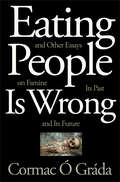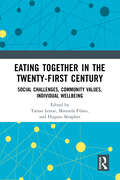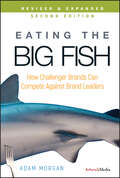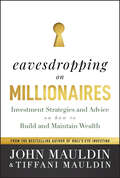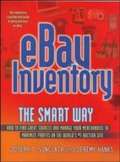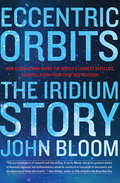- Table View
- List View
Eat the Rich
by P. J. O'RourkeA humorous treatise on economics, a world tour from the 'good capitalism' of Wall Street to the 'bad capitalism' of Cuba, in search of an answer to the age-old question: Why do some places prosper and thrive, while others just suck?
Eat the Rich: A Treatise on Economics
by P. J. O'RourkeIn the tradition of his contemporary classic Parliament of Whores, the man who The Wall Street Journal calls "the funniest writer in America" is back with Eat the Rich, in which he takes on the global economy. P. J. O'Rourke leads you on an hysterical whirlwind world tour from the "good capitalism" of Wall Street to the "bad socialism" of Cuba in search of the answer to an age-old question: "Why do some places prosper and thrive, while others just suck?" With stops in Albania, Sweden, Hong Kong, Moscow, and Tanzania, P.J. brings along his incomparable wit and finds hilarity wherever he goes.
Eating People Is Wrong, and Other Essays on Famine, Its Past, and Its Future
by Cormac Ó GrádaFamines are becoming smaller and rarer, but optimism about the possibility of a famine-free future must be tempered by the threat of global warming. That is just one of the arguments that Cormac Ó Gráda, one of the world's leading authorities on the history and economics of famine, develops in this wide-ranging book, which provides crucial new perspectives on key questions raised by famines around the globe between the seventeenth and twenty-first centuries.The book begins with a taboo topic. Ó Gráda argues that cannibalism, while by no means a universal feature of famines and never responsible for more than a tiny proportion of famine deaths, has probably been more common during very severe famines than previously thought. The book goes on to offer new interpretations of two of the twentieth century's most notorious and controversial famines, the Great Bengal Famine and the Chinese Great Leap Forward Famine. Ó Gráda questions the standard view of the Bengal Famine as a perfect example of market failure, arguing instead that the primary cause was the unwillingness of colonial rulers to divert food from their war effort. The book also addresses the role played by traders and speculators during famines more generally, invoking evidence from famines in France, Ireland, Finland, Malawi, Niger, and Somalia since the 1600s, and overturning Adam Smith's claim that government attempts to solve food shortages always cause famines.Thought-provoking and important, this is essential reading for historians, economists, demographers, and anyone else who is interested in the history and possible future of famine.
Eating Together in the Twenty-first Century: Social Challenges, Community Values, Individual Wellbeing
by Hugues Séraphin Tamas Lestar Manuela PilatoThis book presents theoretical and empirical insights on communal food and dining practices which challenge the less sustainable and often solitary lifestyles encouraged by a social system based on unlimited growth.
Eating Tomorrow: Agribusiness, Family Farmers, and the Battle for the Future of Food
by Timothy A. Wise<p>A major new book that shows the world already has the tools to feed itself, without expanding industrial agriculture or adopting genetically modified seeds, from the Small Planet Institute expert <p>Few challenges are more daunting than feeding a global population projected to reach 9.7 billion in 2050--at a time when climate change is making it increasingly difficult to successfully grow crops. In response, corporate and philanthropic leaders have called for major investments in industrial agriculture, including genetically modified seed technologies. Reporting from Africa, Mexico, India, and the United States, Timothy A. Wise's Eating Tomorrow discovers how in country after country agribusiness and its well-heeled philanthropic promoters have hijacked food policies to feed corporate interests. <p>Most of the world, Wise reveals, is fed by hundreds of millions of small-scale farmers, people with few resources and simple tools but a keen understanding of what and how to grow food. These same farmers--who already grow more than 70 percent of the food eaten in developing countries--can show the way forward as the world warms and population increases. Wise takes readers to remote villages to see how farmers are rebuilding soils with ecologically sound practices and nourishing a diversity of native crops without chemicals or imported seeds. They are growing more and healthier food; in the process, they are not just victims in the climate drama but protagonists who have much to teach us all.</p>
Eating the Big Fish: How Challenger Brands Can Compete Against Brand Leaders (Second Edition)
by Adam MorganEATING THE BIG FISH : How Challenger Brands Can Compete Against Brand Leaders, Second Edition, Revised and Expanded The second edition of the international bestseller, now revised and updated for 2009, just in time for the business challenges ahead. It contains over 25 new interviews and case histories, two completely new chapters, introduces a new typology of 12 different kinds of Challengers, has extensive updates of the main chapters, a range of new exercises, supplies weblinks to view interviews online and offers supplementary downloadable information.
Eaton Corporation: Portfolio Transformation and The Cost of Capital
by Daniel Fisher Benjamin C. Esty E. Scott MayfieldIn 2000, Eaton Corporation was broadly diversified industrial conglomerate. But its strategy was evolving and its focus was narrowing around "power management" and more recently on "intelligent power," the use of digitally enable products and services designed to enhance efficiency and reliability. To implement this transition, Eaton had acquired more than 70 companies and divested another 50. Such active portfolio management required Eaton to regularly assess the prospects of each business unit-the profit and growth potential-and to explore opportunities to enhance its capabilities through acquisitions. In January 2020, Eaton got an offer from Danfoss, a Danish conglomerate, to buy its hydraulics business for $3.3 billion. Recently appointed CEO Craig Arnold must decide whether this deal makes sense strategically and financially. In particular, he must decide if $3.3 billion is a fair price for the firm's hydraulics business.
Eaton Corporation: Portfolio Transformation and The Cost of Capital (Abridged)
by Daniel Fisher Benjamin C. Esty E. Scott MayfieldIn 2000, Eaton Corporation was a broadly diversified industrial conglomerate. But its strategy was evolving and its focus was narrowing around "power management" and more recently on "intelligent power," the use of digitally enabled products and services designed to enhance efficiency and reliability. To implement this transition, Eaton had acquired more than 70 companies and divested another 50. Such active portfolio management required Eaton to regularly assess the prospects of each business unit-the profit and growth potential-and to explore opportunities to enhance its capabilities through acquisitions. In January 2020, Eaton got an offer from Danfoss, a Danish conglomerate, to buy its hydraulics business for $3.3 billion. Recently appointed CEO Craig Arnold must decide whether this deal makes sense strategically and financially. In particular, he must decide if $3.3 billion is a fair price for the firm's hydraulics business. This abridged version is shorter than the original version (HBS Case #221-006) and does not contain the appendix that explains and derives the formulas for the WACC using the capital asset pricing model (CAPM).
Eaton's: The Trans-Canada Store (Landmarks)
by Bruce Allen KopytekExplore the broad, fascinating history of the Eaton's department store empire. Exhaustively researched and thoughtfully written by a prominent department store historian. Canada's largest and most well-known department store, Eaton's was an icon of Canadian culture. From its founding in 1869 to its famed catalogue and network of large stores spreading coast to coast, Eaton's offered something for everyone, in grand style. Relive the days when this remarkable store was a fixture in every Canadian province and served its customers with a distinctive personality that has all but vanished from the retail landscape.
Eavesdropping on Millionaires: Investment Strategies and Advice on How to Build and Maintain Wealth
by John Mauldin Tiffani MauldinDiscover how the wealthy think about, earn, spend, and invest money In Eavesdropping on Millionaires: Investment Strategies and Advice on How to Build and Maintain Wealth, John and Tiffani Mauldin of Mauldin Economics, follow millionaires over 12 years to deliver a one-of-a-kind money management guide based on the investment habits, lessons, and techniques used by a cross-section of affluent people. The book provides revelatory insights to those aspiring to new financial heights, investment managers who want to know more about their clients, and for those firmly on the path of financial freedom – a rare window into the lives of your peers. The authors show you how to achieve significant wealth by demonstrating how real people have already traveled that road. You’ll find: Discussions of how the subjects of the book made their money, how they invested, how they spent, and the plans they’ve created for the immediate future. Explorations of how millionaires enjoy life, their outlooks, mistakes, pivotal lessons learned, how they teach their children about money, and their personal spending habits. Examinations of how the affluent make important decisions and deal with adverse market and money events like bear markets, recessions, career changes, and life transitions.An inspiring and eminently practical resource about how people gain, maintain, and grow significant fortunes in the real world, Eavesdropping on Millionaires is a must-read roadmap to wealth for contemporary investors and those serious about financial freedom.
Ebay 2014. Por Qué No Está Vendiendo Nada En Ebay Y Qué Puede Hacer Al Respecto
by Nick Vulich Mariana Barrancos¿Quiere ganar dinero vendiendo en eBay?eBay 2014 es el manual que faltaba para aprender a ganar dinero vendiendo en eBay. Los vendedores diarios se debaten sobre las siguientes preguntas: ¿Cómo vender? ¿Qué vender? ¿Cómo mantenerse actualizado con todos los cambios de eBay? Si realmente quiere triunfar en eBay, deberá ser capaz de manejar todos estos temas. eBay 2014 analiza las nuevas actualizaciones para vendedores de eBay y cómo inciden en su negocio. Abarca los problemas actuales que tienen los vendedores de eBay con la visibilidad de las publicaciones, las imágenes, los precios y mucho más. Aprenda a: *Redactar descripciones eficaces *Tomar imágenes que venden *Poner precio a sus artículos para la venta *Manejar los métodos de contabilidad de eBay Léalo hoy libere todo su potencial de ventas.¿Está cansado de los mismos consejos de siempre que brindan los libros sobre eBay, escritos por personas que no conocen la diferencia entre una publicación de subasta y una de precio fijo? Quince años como vendedor destacado de eBay le da a Nick una perspectiva única sobre cómo vender en eBay. La serie The eBay Selling Made Easy le dice las cosas como son. Freaking Idiots Guide to Selling on eBay y eBay Unleashed le indicarán cómo comenzar a vender en eBay. Le mostrarán cómo abrir una cuenta en eBay y PayPal, y lo guiarán de la mano para que pueda hallar productos para vender y concretar su primera venta.eBay 2014 cambia un poco y habla sobre algunas técnicas de venta más avanzadas, y cómo trasladar sus ventas fuera de eBay. Si alguna vez pensó en vender en Amazon, Etsy o eCrater, este libro y Sell It Online (Vender en Internet) le darán más información acerca de cómo hacer la transición de su negoc
Ebay Amazon Arbitrage: Unleashes an Endless Tsunami of High Ticket Paydays
by Brian GravesUnleashes An Endless Tsunami Of High Ticket Paydays Book Description Underground Amazon seller discovers the magical missing word and unleashes an endless tsunami of high ticket paydays. I will provide you with full details of the niche I make money in. I made $82 on the first Item. I bought more from the same seller until I’d bought over 100 Items from him, making between $70 and $150 on each product. I take you through a case study where I show you exactly how to do it. Templates are also provided where necessary to make things as simple as possible. What You Will Learn Buying offline to sell on Ebay and Amazon Buying on other sites to sell on Ebay and Amazon Even more arbitrage tactics to add to you arsenal Case study to show you the exact steps Finding Your Niche And loads more....
Ebay Desatado: Guía Para Principiantes Para Ganar Dinero En Ebay
by Nick Vulich Miguel Segura¿Alguna vez has querido vender en eBay, pero no tenías claro cómo empezar?eBay Desatado es tu guía personal para ganar dinero en eBay. El autor, Nick Vulich, ha completado más de 29.000 transacciones en eBay en los últimos trece años y conoce los pormenores de la venta en eBay y se ofrece para acompañarte de la mano por el proceso de venta.¿Te preocupa no tener nada que vender?No te preocupes. Echa un vistazo a tu alrededor. Todo el mundo tiene docenas de objetos por su casa y en el garaje que puede empezar a vender hoy. Sólo porque ya no no lo utilices tú para tu viejo VCR, sistema de juego, o portátil eso no significa que alguien no lo quiera. La gente ama llevarse una ganga. Ayúdales a conseguir lo que quieren y gana algo de dinero también.En este libro, vas a aprender cómo:1) Decidir qué vender2) Cómo configurar tu cuenta de vendedor de eBay3) Cómo configurar tu cuenta de PayPal (para poder recibir el pago rápido)4) Instrucciones paso a paso de cómo anunciar tu primer artículo en eBay5) Veintiocho consejos y trucos para potenciar tu venta6) Cómo enviar tus artículos7) Cómo investigar los artículos para poder conseguir el mejor precio siempre8) Una introducción al servicio al cliente - al estilo eBayNo dejes que el miedo a lo desconocido te eche para atrás1) Se estima que más de 450.000 personas trabajan vendiendo artículos en eBay a tiempo completo2) Unos millones más de personas utilizan eBay para hacer algún dinero extra para comprarse un coche nuevo, pagar el colegio de sus hijos o hacer unas vacaciones de ensueño - ¿por qué no tú?3) Otros millones más gente querrían vender en eBay, pero tienen miedo de intentarlo4) eBay desatado te guiará paso a paso en la decisión de decidir qué vender, registrarte en una cuenta de eBay y PayPal, para anunciar tu primera subasta.
Ebay Inventory the Smart Way: How to Find Great Sources and Manage Your Merchandise to Maximize Profits on the World's #1 Auction Site
by Joseph T. Sinclair Jeremy HanksCorresponding to the ongoing trend of making money using eBay, this book focuses on inventory sources and suggests tips for deciding on and finding products, cost-effectiveness, inventory management software, supplier-retailer relationships, shipping methods including drop shipping, consignment, and various sources for finding products such as trade markets and organizations, manufacturers, wholesalers, inventory services, closeouts, directories, picking, local sources, arts and crafts, packaging, special products, and using eBay itself. Also discussed are scams, foreign goods, and pawnshops. No bibliography is provided. Sinclair is author of all of the books in the "eBay the Smart Way" series; Hanks is cofounder and CEO of a drop shipper in the online product sourcing industry. Annotation ©2006 Book News, Inc., Portland, OR (booknews.com)
Ebay Rescue Profit Maker
by Kevin W. BoydPump up your profits on eBay®! When many eBay® sellers run out of items to sell, they often head straight to the outlet malls looking for super sales, or go to trade shows, or shop online liquidation sites looking for larger quantities of items, sometimes purchasing pallets of product. Only then do they discover their problem: the items they just purchased are selling on eBay® for less than what they paid! Now they no longer have to repeat this pattern with costly hit-or-miss results. In this guide, an eBay® PowerSeller shares the proprietary product selection and evaluation methodology he has developed based on seven years of professional eBay® selling, instructing, and consulting. In eBay® Rescue Profit Maker, readers learn how to:• Determine what to sell • Determine the reputable product suppliers • Create enticing listings and use advanced listing techniques • &“Spy&” on their competition • Provide superior customer service • Expand and improve their customer base
Ebay Scatenato Guida Per Il Principiante Che Vuole Fare Soldi Su Ebay
by Nick Vulich Luisa Agnese Dalla FontanaHai mai pensato di vendere su eBay ma non sapevi d ache parte cominciare. eBay scatenato è la tua guida personale per fare soldi su eBay, seguendo i consigli dell'autore, che negli ultimi 13 anni ha completato oltre 29.000 transazioni su eBay e ti guiderà passo passo insegnandoti a vendere.Guardati intorno: puoi cominciare a vendere quello che hai in casa e non usi più.Questo libro ti insegnerà adecidere che cosa vendere.Aprire un account su eBayAprire un conto PayPalFare la tua prima inserzione.28 trucchi e spunti per aumentare le venditeEffettuare le spedizioni nel migliore dei modiStabilire il prezzo dei tuoi articoliIl servizio al consumatore nello stile di eBayRicorda che oltre 450.000 persone si guadagnano da vivere vendendo su eBay e milioni se ne avvalgono per integrare gli introiti e potersi permettere un'auto nuova o una vacanza da sogno. Puoi farlo anche tu! Per cominciare ti basterà meno di un'ora. Non aspettare un minuto di più! Ordina la tua copia di questo libro ORA!!!
Ebay, El Negocio De 100.000 $ Consigue Beneficios De Locura Vendiendo En Ebay Y Amazon
by Braun Schweiger Irune Hidalgo¿Estás preparado para ganar dinero online? eBay, el Negocio de 100.000$ es tu entrada para vender en eBay y Amazon. Se estima que actualmente más de medio millón de personas se ganan la vida vendiendo en eBay y Amazon. Tú también puedes. Se trata de empezar e ir haciendo crecer tu negocio. No sabes nada de eBay ni Amazon, no te preocupes. eBay, el Negocio de 100.000$ te ayuda a decidir qué vender, cómo vender y cómo obtener el mayor beneficio posible. Si alguna vez has querido iniciar un negocio propio, la venta online es el mejor modo de empezar. 1. Puedes empezar con una inversión mínima. La mayoría de los vendedores empiezan vendiendo artículos que tienen por su casa. 2. Puedes empezar desde casa, a media jornada mientras continúas con tu trabajo a jornada completa. 3. No hay unas horas establecidas. Si eres un padre o una madre que se queda en casa, puedes vender cuando los niños están en el colegio o después de que vayan a la cama por la noche. 4. Es una ventaja si ya tienes el equipo necesario para empezar. Puedes publicar artículos desde tu portátil, tu teléfono móvil o tablet. Compra un equipo mejor cuando tus ventas aumenten. ¿No estás seguro de qué vender o cómo conseguir productos? No sufras. También lo incluimos aquí. Descubre una larga lista de artículos que seguramente tengas por tu casa para empezar a vender. Explora lugares en los que adquirir inventario localmente, mercadillos, venta de bienes e incluso tiendas minoristas. Los artículos rentables están a tu alrededor. Sólo necesitas saber qué buscar. No sabes nada de vender en eBay ni en Amazon. No hay problema. eBay, el Negocio de 100.000$ explica cómo vender en eBay y Amazon. Aprende todo lo que necesitas saber para empezar y crecer con un negocio online de éxito. Léelo esta mañana Publica tu primer artículo esta tarde Gana dinero mañana
Ebb and Flow: Volume 1. Water, Migration, and Development
by Jason Russ Damania Anders Jägerskog Esha Zaveri Amjad KhanMigration shapes the lives of those who move and transforms the geographies and economies of their points of departure and destinations alike. The water sector, and the availability of water itself, implicitly and explicitly shape migration flows. Ebb and Flow: Volume 1. Water, Migration, and Development presents new global evidence to advance our understanding of how fluctuations in water availability, as induced by rainfall shocks, influence internal migration, and hence regional development. It finds that cumulative water deficits result in five times as much migration as water excess does. But there are important nuances in why and when these events lead to migration. Where there is extreme poverty and migration is costly, water deficits are more likely to trap people than induce them to migrate. Water shocks can also influence who migrates. Workers leaving regions because of water deficits are often less advantaged than typical migrants and bring with them lower skills, raising important implications for the migrants themselves and receiving regions. Cities are the destination of most internal migrants, but even here, water scarcity can haunt them. Water shortages in urban areas, which lead to so-called day zero events, can significantly slow urban growth and compound the vulnerability of migrants. No single policy can be completely effective at protecting people and their assets from water shocks. Instead, the report puts forth a menu of overlapping and complementary policy options that target both people and places to improve livelihoods and turn water-induced crises into opportunities for growth. A key message is that policies that focus on reducing the impacts of water shocks must be complemented by strategies that broaden opportunities and build the longterm resilience of communities. Doing so will give individuals more agency to determine the best outcome for themselves and to thrive wherever they may choose to locate.
Ebb and Flow: Volume 2. Water in the Shadow of Conflict in the Middle East and North Africa
by Richard Damania Anders Jägerskog Russ Esha Zaveri Edoardo BorgomeoThe Middle East and North Africa Region encapsulates many of the issues surrounding water and human mobility. It is the most water-scarce region in the world and is experiencing unprecedented levels of forced displacement. Ebb and Flow: Volume 2. Water in the Shadow of Conflict in the Middle East and North Africa examines the links between water risks (harmful outcomes related to water, from droughts and floods to lack of sanitation), conflict, and forced displacement. It aims to better explain how to address the vulnerabilities of forcibly displaced persons and their host communities, and to identify water policy and investment responses. Contrary to common belief, the report finds that the evidence linking water risks with conflict and forced displacement in the region is not unequivocal. Water risks are more frequently related to cooperation than to conflict at both domestic and international levels. But while conflict is not necessarily a consequence of water risks, the reverse is a real and concerning phenomenon: conflict amplifies water risks. Since 2011, there have been at least 180 instances of intentional targeting of water infrastructure in conflicts in Gaza, Libya, the Syrian Arab Republic, and the Republic of Yemen. Forcibly displaced persons and their host communities face myriad water risks. Access to safe drinking water is a daily struggle for millions of forcibly displaced Iraqis, Libyans, Palestinians, Syrians, Yemenis, and international migrants in the region, heightening public health risks. Tanker trucks often help fill the gap; however, significant issues of water quality, reliability, and affordability remain. Host communities also face localized declines in water availability and quality as well as unplanned burdens on water services following the arrival of forcibly displaced persons. The reality of protracted forced displacement requires a shift from humanitarian support toward a development approach for water security, including structured yet flexible planning to deliver water services and sustain water resources for forcibly displaced persons and their host communities.
Ebony Magazine
by Steven Rogers Derrick JacksonFor nearly 75 years, the Johnson Publishing Company has been the most successful African American magazine publisher. Its flagship Ebony magazine was an iconic coffee table fixture for decades in black households of all classes, making founder John H. Johnson the first African American to make the Forbes 400 list of richest Americans. But the privately-held company was now in the hands of his daughter and faced the bracing, debilitating winds besetting the entire magazine and newspaper industry. Linda Johnson Rice now had to decide what to do with the publications and brands of the company.
EbonyLife Media (A)
by Feng Zhu Andy Wu Pippa Tubman Armerding Wale LawalFounded by Mosunmola "Mo" Abudu in 2012 with a mission to bring high-quality African stories to the world, EbonyLife was the company behind many of Nigeria's biggest films and TV shows. The company began as a television channel on the Africa-wide direct broadcast satellite service DStv. By 2020, EbonyLife had produced over 5,000 hours of television content and Nigeria's top-three highest-grossing movies. With a need for greater control over its production schedules and following the end of its relationship with DStv EbonyLife launched EbonyLife ON (EL ON), an on-demand streaming service. However, EbonyLife struggled to grow its subscribers of EL ON. Abudu started to rethink whether to continue fighting to grow EL ON. Should EbonyLife focus instead on co-production deals with international media distributors such as Netflix, Sony and AMC?
Ebro Puleva
by David E. Bell Mary Shelman Rocio Reina Paniagua Antonio Garcia de CastroOnce Spain's largest sugar company, Ebro Puleva has been transformed through a series of international acquisitions into the world's largest package rice company and second largest pasta company. In 2009, Chairman Antonio Hernandez Callejas must decide how to proceed now that the firm's sugar business has been sold. A specific question is whether the firm should sell its dairy business, which is limited to Spain. The case discusses the firm's branding strategy, approach to integration, and organizational structure used to manage a global business. The case also describes several changes in consumer behavior and the retail food market brought on by the global financial crisis.
Ebu$iness: 7 Steps To Get Your Small Business Online... And Making Money Now!
by Paul WallbankIs your business website a money pit? A source of frustration? A time-waster? Does your business even have an online presence? It's time to get your website working for you and making money. The web and social media have become the new shopfronts where customers, staff and suppliers look to find people to do business with. eBu$iness will help anyone who wants to set up and maintain a professional web presence by showing you how to: register an effective domain name set up your own free or cheap website use social media to your advantage optimise your website so that search engines and customers can find you take advantage of free local listing services and much more. Whether you already have a website or you're just starting out, eBu$iness gives you the tools and know-how to save time and money, and will help you to grow your business and make a profit.
Eccentric Orbits: The Iridium Story
by John Bloom“In the early 1990s, Motorola, the legendary American technology company developed a revolutionary satellite system called Iridium that promised to be its crowning achievement. Light years ahead of anything previously put into space, and built on technology developed for Ronald Reagan’s “Star Wars,” Iridium’s constellation of 66 satellites in polar orbit meant that no matter where you were on Earth, at least one satellite was always overhead, and you could call Tibet from Fiji without a delay and without your call ever touching a wire. ridium the satellite system was a mind-boggling technical accomplishment, surely the future of communication. The only problem was that Iridium the company was a commercial disaster. Only months after launching service, it was $11 billion in debt, burning through $100 million a month and crippled by baroque rate plans and agreements that forced calls through Moscow, Beijing, Fucino, Italy, and elsewhere. Bankruptcy was inevitable—the largest to that point in American history. And when no real buyers seemed to materialize, it looked like Iridium would go down as just a “science experiment.” That is, until Dan Colussy got a wild idea. Colussy, a former head of Pan-Am now retired and working on his golf game in Palm Beach, heard about Motorola’s plans to “de-orbit” the system and decided he would buy Iridium and somehow turn around one of the biggest blunders in the history of business. In “Eccentric Orbits”, John Bloom masterfully traces the conception, development, and launching of Iridium and Colussy’s tireless efforts to stop it from being destroyed, from meetings with his motley investor group, to the Clinton White House, to the Pentagon, to the hunt for customers in special ops, shipping, aviation, mining, search and rescue—anyone who would need a durable phone at the end of the Earth. Impeccably researched and wonderfully told, “Eccentric Orbits” is a rollicking, unforgettable tale of technological achievement, business failure, the military-industrial complex, and one of the greatest deals of all time.
Eccentric Tales of Boring, Oregon
by Bruce HaneyThe town of Boring has seen more than its fair share of interesting events since its founding in 1903. From secretly hiring an up-and-coming boxer to fight the town bully to the time firecrackers were blamed for burning down half the town, memorable moments abound. Discover the story of the wild man who lived in the woods and the attempts of Prohibition-era moonshiners to evade the law. Uncover the true identity of the Wild West Gang and the real story of a runaway train loaded with potatoes. Join author Bruce Haney as he explores the peculiar tales of an exciting town.


